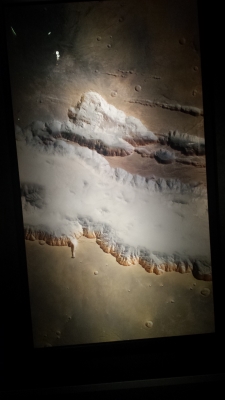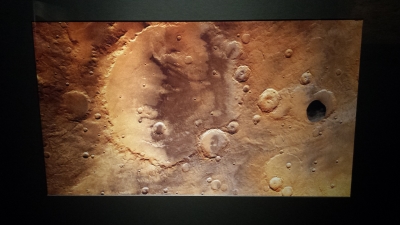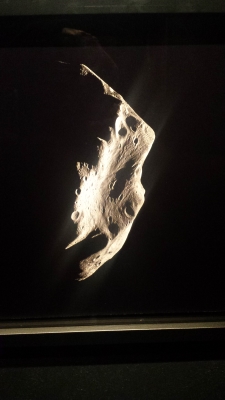
A few days ago I went to the Natural History Museum’s Otherworlds exhibition. This turned out to be well worth the trip – not very large in extent, but beautifully put together, and the ample space in the hall to walk around and look at the pictures helped a lot. The pictures attached here are my own, taken as I walked around, and so nothing like the clarity and resolution of the real ones.
The arrangement was by planet, starting with Earth and Moon, then taking in the inner solar system planets of Mercury and Venus – together with some spectacular images of the Sun itself – and then heading progressively outwards past Mars and Jupiter, ending with Pluto.
In my opinion, Mars and Jupiter came out best in the gallery as a whole, The Sun pictures were striking, but one suspects that those two planets – and Saturn to a lesser extent, mainly focusing on the rings – were the collator’s preferred choice.

I was particularly interested in this picture of Mars’ moon Phobos – the dark object to the right of the picture – as it will feature in the successor to Far from the Spaceports.

But asteroid pictures were thin on the ground, and some of what was there were taken of so-called earth-grazing bodies, meaning that they do not orbit between Mars and Jupiter, but instead have a rather eccentric orbit swinging well inside that of Mars. This particular image is of Lutetia, taken by ESA’s Rosetta probe as it headed towards its rendezvous with a comet. There were no pictures out of the many sent back by the Dawn probe from Ceres and Vesta, which I found a little disappointing.
The really outer planets – Uranus, Neptune, and dwarf Pluto, got just one picture each, again a bit surprising with Pluto considering all that has been coming back from New Horizons. But the choice was a fine one to conclude the show, and neatly established a basic similarity between the familiar – Earth – and the unknown.
All in all a great exhibition, and well worth catching up on if it makes its way to a location near you.
